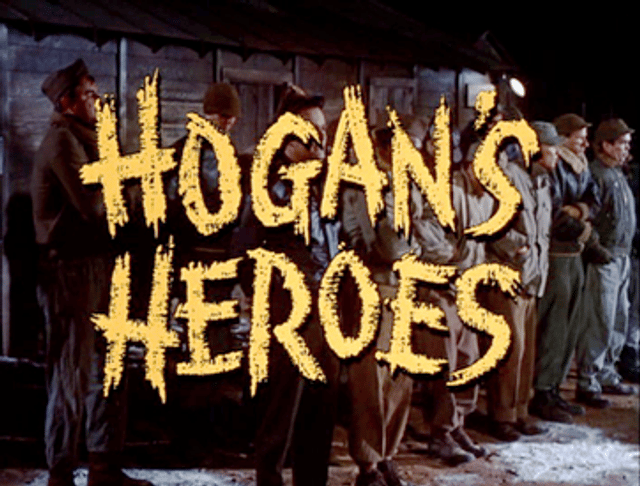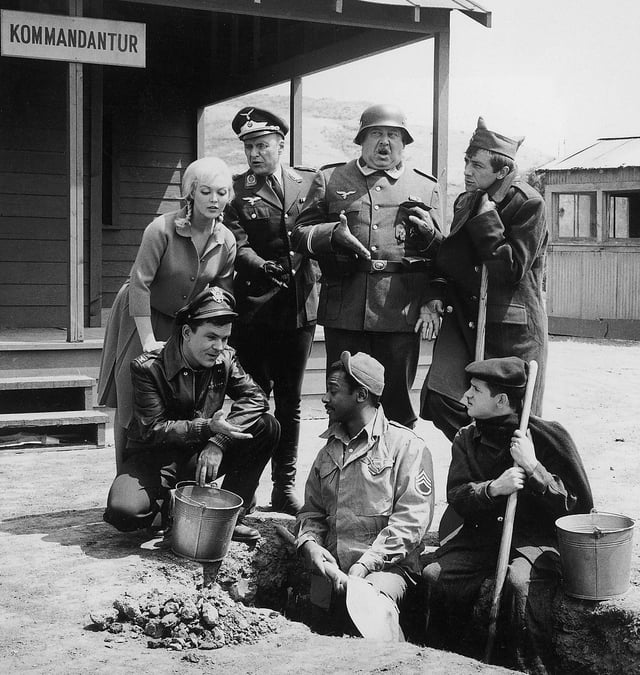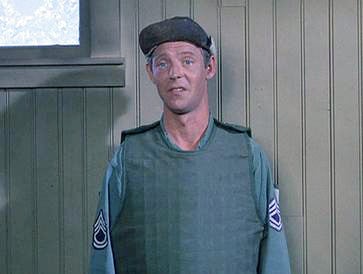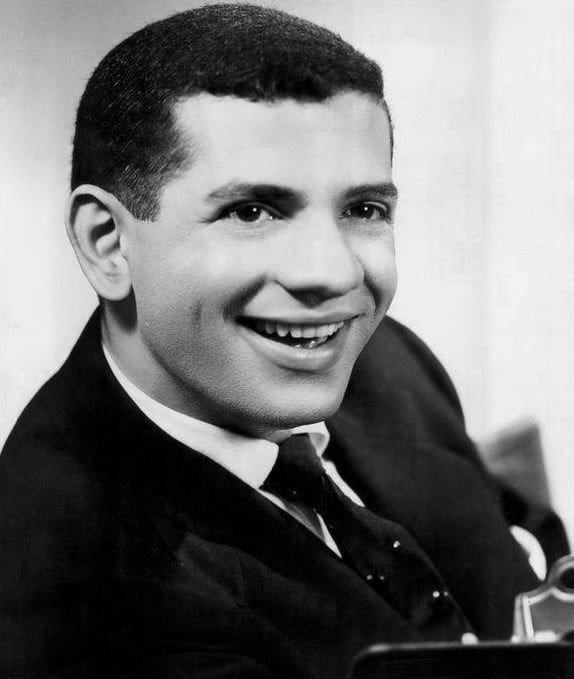Hogan's Heroes

Hogan's Heroes

| Hogan's Heroes | |
|---|---|
| Created by |
|
| Starring |
|
| Composer(s) | Jerry Fielding |
| Country of origin | United States |
| No.of seasons | 6 |
| No.of episodes | 168 (Pilot episode—B/W; 167—color)(list of episodes) |
| Production | |
| Producer(s) | Edward H. Feldman[1] |
| Running time | 25 minutes |
| Productioncompany(s) |
|
| Distributor |
|
| Release | |
| Original network | CBS |
| Picture format | 4:3 SDTV |
| Original release | September 17, 1965 (1965-09-17) – March 28, 1971 (1971-03-28) |
Hogan's Heroes is an American television sitcom set in a German prisoner of war (POW) camp during World War II. It ran for 168 episodes from September 17, 1965, to April 4, 1971, on the CBS network. Bob Crane starred as Colonel Robert E. Hogan, coordinating an international crew of Allied prisoners running a special operations group from the camp. Werner Klemperer played Colonel Wilhelm Klink, the incompetent commandant of the camp, and John Banner played the bungling but lovable sergeant-of-the-guard, Sergeant Hans Schultz.
| Hogan's Heroes | |
|---|---|
| Created by |
|
| Starring |
|
| Composer(s) | Jerry Fielding |
| Country of origin | United States |
| No.of seasons | 6 |
| No.of episodes | 168 (Pilot episode—B/W; 167—color)(list of episodes) |
| Production | |
| Producer(s) | Edward H. Feldman[1] |
| Running time | 25 minutes |
| Productioncompany(s) |
|
| Distributor |
|
| Release | |
| Original network | CBS |
| Picture format | 4:3 SDTV |
| Original release | September 17, 1965 (1965-09-17) – March 28, 1971 (1971-03-28) |
Overview
Hogan's Heroes centers on U.S. Army Air Forces Colonel Robert Hogan and his staff of experts who are prisoners of war (POW) in the fictional Stalag 13. The group secretly use the camp to conduct Allied espionage and sabotage and to help escaped Allied POWs from other prison camps via a secret network of tunnels that operate under the ineptitude of commandant Colonel Klink and his main Sergeant Schultz. The prisoners cooperate with resistance groups (collectively called "the Underground"), defectors, spies, counterspies, and disloyal officers to accomplish this. They devise schemes such as having Sergeant Andrew Carter visit the camp disguised as Adolf Hitler as a distraction, or rescuing a French Underground agent from Gestapo headquarters in Paris.
Klink technically has a perfect operational record as camp commandant as no prisoners have successfully escaped during his tenure; Hogan and his men assist in maintaining this record so they can continue with their covert operations. Because of Klink's record, and the fact that the Allies would never bomb a POW camp, Stalag 13 appears to be a very secure location. As a result, the Germans often use the camp for high level meetings, to hide important persons and develop secret projects. Klink frequently has many other important visitors and is temporarily put in charge of special prisoners. This brings the prisoners in contact with many important VIPs, scientists, spies, high-ranking officers, and some of Germany's most sophisticated and secret weapons projects such as the Wunderwaffe and the Manhattan Project, of which the prisoners take advantage in their efforts to hinder the German war effort.
| Season | Episodes | Originally aired | ||
|---|---|---|---|---|
| First aired | Last aired | |||
| 1 | 32 | September 17, 1965 (1965-09-17) | April 29, 1966 (1966-04-29) | |
| 2 | 30 | September 16, 1966 (1966-09-16) | April 7, 1967 (1967-04-07) | |
| 3 | 30 | September 9, 1967 (1967-09-09) | March 30, 1968 (1968-03-30) | |
| 4 | 26 | September 28, 1968 (1968-09-28) | March 22, 1969 (1969-03-22) | |
| 5 | 26 | September 26, 1969 (1969-09-26) | March 27, 1970 (1970-03-27) | |
| 6 | 24 | September 20, 1970 (1970-09-20) | April 4, 1971 (1971-04-04) | |
Setting
The setting is the fictional Luft Stalag 13 (Camp 13 in early episodes), a prisoner-of-war camp for captured Allied airmen. Like the historical Stalag XIII-C,[2] it is located just outside of a town called Hammelburg, though it is inconsistently placed throughout the series. In the second season episode "Killer Klink", Sergeant Schultz states that the camp is 106.7 kilometres (66.3 mi) away from his home in Heidelberg by direct flight; this is well reflective of Heidelberg's direct distance from the actual Hammelburg. The show is a combination of several writing styles that were popular in the 60s: the "wartime" show, the "spy" show, and "camp comedy".
Although in reality Hammelburg is well inland in Franconia, several first season episodes place the camp closer to the North Sea (perhaps to make successful escapes to England more plausible). In "Anchors Aweigh, Men of Stalag 13", Colonel Klink specifies that the camp is 60 miles (97 km) from the North Sea; three episodes earlier ("Hogan's Hofbrau"), he had stated that the coast was a mere five miles (8 km) away. To complicate matters even further, it is mentioned in several episodes (e.g. "The Safecracker Suite") that the nearest major city to the camp is Düsseldorf, which is also fairly far inland and by air is about 157 miles (253 km) from the actual Hammelburg.
The camp has 103 Allied prisoners of war (POWs) during the first season, but becomes larger by the end of the series.
Cast

The cast of the show. From left to right: Frau Helga, Colonel Hogan, Commandant Klink, Sergeant Schultz, Sergeant Kinchloe, Corporal LeBeau, and Corporal Newkirk. Sergeant Carter is absent from the image

Larry Hovis as Sgt Carter
Bob Crane as Colonel Robert Hogan, the senior ranking POW officer and the leader of the men in the POW camp. He uses his wit and ingenuity in missions to counter the Nazis' battle plans. Crane was offered the role after appearing as "guy next door" types in television shows like The Dick Van Dyke Show and as a regular in The Donna Reed Show.[3][4]
Werner Klemperer as Colonel Wilhelm Klink, the commandant of the POW camp. He is painfully unaware of the men's operation and believes the camp has a perfect escape record under his command. Klemperer was from a Jewish family in real life (his father was the famous orchestral conductor Otto Klemperer) and found the role to be a "double-edged sword"; his agent failed to tell him the role was intended to be comedic. Klemperer remarked, "I had one qualification when I took the job: if they ever wrote a segment whereby Colonel Klink would come out the hero, I would leave the show."[5]
John Banner as Sergeant Hans Schultz, Klink's main sergeant. He is a clumsy and inept, but extremely affable man who often gives out information to the prisoners for bribes, often LeBeau's gourmet cooking. Banner was, in reality, born to Jewish parents and was a U.S. Army sergeant during World War II.[6][7]
Ivan Dixon as Sergeant James Kinchloe, the man responsible for contacting the underground by electronic communications [he was an aircrew radioman]. "Kinch" also acted as Hogan's second-in-command (although technically outranked by Carter). Kinchloe usually uses Morse code, telephones, and a coffee pot radio to receive and transmit messages. Casting Dixon, or any African-American actor as a positively shown supporting character, was a major step for a television show in the mid 1960s.[8] Dixon left the show prior to the final season and was replaced by Kenneth Washington as Sgt. Richard Baker.
Larry Hovis as Sergeant Andrew Carter, an expert in chemistry, explosives and demolitions [he was the aircrew bombardier]. He is in charge of making and producing chemicals, and explosive devices in order to thwart the Nazis' plans. Hovis was discovered by Richard Linke, the producer of The Andy Griffith Show, and was a recurring character on Gomer Pyle U.S.M.C. before landing the role of Sergeant Carter.[9]
Robert Clary as Corporal Louis LeBeau, a gourmet chef and patriotic Frenchman. He has trained the guard dogs to be friendly towards the prisoners and uses their kennels as tunnels to bring their allies into. Clary is Jewish in real life, and was deported to a Nazi concentration camp but survived by using his talent in singing and dancing in shows. Clary said in an interview with the Los Angeles Times, "Singing, entertaining, and being in kind of good health at my age, that's why I survived. I was very immature and young and not really fully realizing what situation I was involved with ... I don't know if I would have survived if I really knew that."[10]
Richard Dawson as Corporal Peter Newkirk, the group's conman, magician, pick-pocket, card sharp, forger, bookie, tailor, lock picker, and safe cracker. He is a skilled tailor and is in charge of making uniforms for POWs impersonating high ranking German officials. Dawson's role as a military prisoner in the film King Rat was reportedly the reason for his spot in Hogan's Heroes.[11]
Broadcast history
Friday at 8:30–9:00 p.m. on CBS: September 17, 1965 – April 7, 1967; September 26, 1969 – March 27, 1970
Saturday at 9:00–9:30 p.m. on CBS: September 9, 1967 – March 22, 1969
Sunday at 7:30–8:00 p.m. on CBS: September 20, 1970 – April 4, 1971
Production

Robert Clary said that during World War II, he spent three years in a concentration camp and still has his ID tattoo on his arm
Outdoor scenes were filmed on the 40 Acres Backlot in Culver City, California.[12] After the series ended in 1971, the set remained standing until it was destroyed in 1974 while the final scene of Ilsa, She Wolf of the SS was filmed.[13] The theme music was composed by Jerry Fielding, who added lyrics to the theme for Hogan's Heroes Sing The Best of World War II – an album featuring Dixon, Clary, Dawson, and Hovis singing World War II songs. The song also appeared on the album Bob Crane, His Drums and Orchestra, Play the Funny Side of TV.[12]
The actors who played the four major German roles—Werner Klemperer (Klink),[14] John Banner (Schultz), Leon Askin (Burkhalter), and Howard Caine (Hochstetter)—were Jewish. Furthermore, Klemperer, Banner, Askin, and Robert Clary (LeBeau) were Jews who had fled the Nazis during World War II. Clary says in the recorded commentary on the DVD version of episode "Art for Hogan's Sake" that he spent three years in a concentration camp, that his parents and other family members were killed there, and that he has an identity tattoo from the camp on his arm ("A-5714"). Likewise John Banner had been held in a (pre-war) concentration camp and his family was killed during the war. Leon Askin was also in a pre-war French internment camp and his parents were killed at Treblinka. Howard Caine, who was also Jewish (his birth name was Cohen), was American, and Jewish actors Harold Gould and Harold J. Stone made multiple appearances playing German generals. As a teenager, Klemperer fled Hitler's Germany with his family in 1933. During the show's production, he insisted that Hogan always win against his Nazi captors or else he would not take the part of Klink. He defended his playing a Luftwaffe Officer by claiming, "I am an actor. If I can play Richard III, I can play a Nazi." Banner attempted to sum up the paradox of his role by saying, "Who can play Nazis better than us Jews?" Klemperer, Banner, Caine, Gould, and Askin play stereotypical World War II Germans, and all had served in the U.S. Armed Forces during World War II—Banner[15] and Askin in the U.S. Army Air Corps, Caine in the U.S. Navy, Gould with the U.S. Army, and Klemperer in a U.S. Army Entertainment Unit. Werner Klemperer had in 1961 starred as the title character in the serious drama Operation Eichmann, which also featured John Banner in a supporting role as a committed Nazi. Ruta Lee, Theodore Marcuse, and Oscar Beregi, Jr. also appeared in the film, each went on to make several guest appearances on Hogan’s Heroes.
German film distributor KirchGruppe acquired broadcasting rights to the show but initially did not air it out of fear that it would offend viewers. In 1992, episodes were shown on German television for the first time, but the program failed to connect with viewers due to issues with lip syncing.[16] However, after the dialogue was rewritten to make the characters look even more foolish (which ensured that the viewers understood the characters were caricatures), the show became successful. An unseen original character -- "Kalinke" --was introduced as Klink's cleaning lady and perennial mistress who he described as performing most of her cleaning duties in the nude.[16]
Legal issues
Donald Bevan and Edmund Trzcinski, the writers of the 1951 play Stalag 17, a World War II prisoner-of-war story turned into a 1953 feature film by Paramount Pictures, sued Bing Crosby Productions, the show's producer, for infringement. Their lawsuit was unsuccessful. While the jury found in favor of the plaintiffs, the federal judge overruled them. The judge found "striking difference in the dramatic mood of the two works."[12][17]
In 2012, an arbitration hearing was scheduled to determine whether Bernard Fein and Albert S. Ruddy, the creators of the show, had transferred the right to make a movie of Hogan's Heroes to Bing Crosby Productions along with the television rights or had retained the derivative movie rights.[17] In 2013, Fein (through his estate) and Ruddy acquired the sequel and other separate rights to Hogan's Heroes from Mark Cuban via arbitration, and a movie based on the show was planned.[18]
Reception
Hogan's Heroes won two Emmy Awards out of twelve nominations. Both wins were for Werner Klemperer as outstanding supporting actor in a comedy, in 1968 and 1969. Klemperer received nominations in the same category in 1966, 1967 and 1970. The series' other nominations were for comedy series in 1966, 1967 and 1968; Bob Crane for actor in a comedy series in 1966 and 1967; Nita Talbot for supporting actress in a comedy in 1968; and Gordon Avil for cinematography in 1968.[19]
Nielsen ratings
Note: The highest average rating for the series is in bold text.
| Season | Rank | Rating |
|---|---|---|
| #9 | 24.9 |
| #17 | 21.8 (Tied with The CBS Friday Night Movies) |
| Not in the Top 30 | |
| ||
| ||
| ||
Home releases
CBS DVD (distributed by Paramount) has released all six seasons of Hogan's Heroes on DVD in regions 1 and 4. The series was previously released by Columbia House as individual discs, each with five or six consecutive episodes, as well as on a compilation 42 VHS collection of the 168 episodes.
On March 8, 2016, CBS Home Entertainment re-released a repackaged version of the complete series set, at a lower price.[20]
| DVD Name | Episodes | Release dates | |
|---|---|---|---|
| Region 1 | Region 4 | ||
| The Complete First Season | 32 | March 15, 2005 | July 30, 2008 |
| The Complete Second Season | 30 | September 27, 2005 | November 7, 2008 |
| The Complete Third Season | 30 | March 7, 2006 | March 5, 2009 |
| The Complete Fourth Season | 26 | August 15, 2006 | June 3, 2009 |
| The Complete Fifth Season | 26 | December 19, 2006 | August 4, 2009 |
| The Complete Sixth and Final Season | 24 | June 5, 2007 | September 30, 2009 |
| The Complete Series (The Kommandant's Collection) | 168 | November 10, 2009 | December 3, 2009 |
Merchandise and promotion
In 1965, Fleer produced a 66-trading card set based on the series.[21] Dell Comics produced nine issues of a series based on the show from 1966 to 1969, all with photo covers. The artwork was provided by Henry Scarpelli.[22] Mad magazine #108 (January 1967) parodied the show as "Hokum's Heroes". An additional one-page parody called "Hochman's Heroes" took the show's premise to the next level by setting it in Buchenwald concentration camp.[23]
In 1968, Clary, Dawson, Dixon, and Hovis recorded an album titled Hogan's Heroes Sing the Best of World War II, which included lyrics for the theme song.[24] While the show was in production, Crane, Klemperer, Askin, and Banner all appeared (as different characters) in the 1968 film The Wicked Dreams of Paula Schultz.
See also
'Allo 'Allo!
Auto Focus
Colditz Castle
The Colditz Story
The Great Escape
Heil Honey I'm Home!
OFLAG XIII-B – officers camp located outside Hammelburg
Stalag 17
Stalag XIII-C
Escape to Victory
